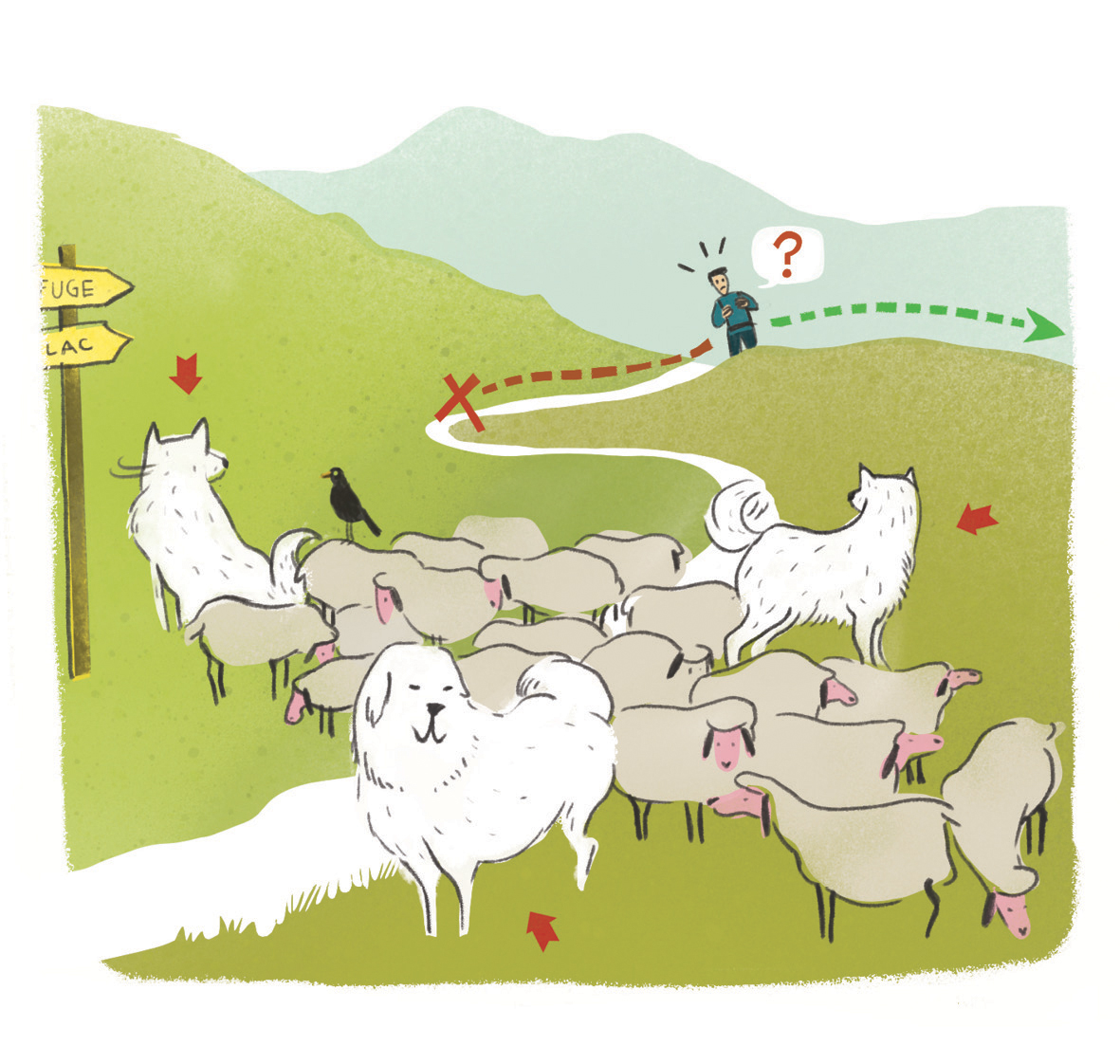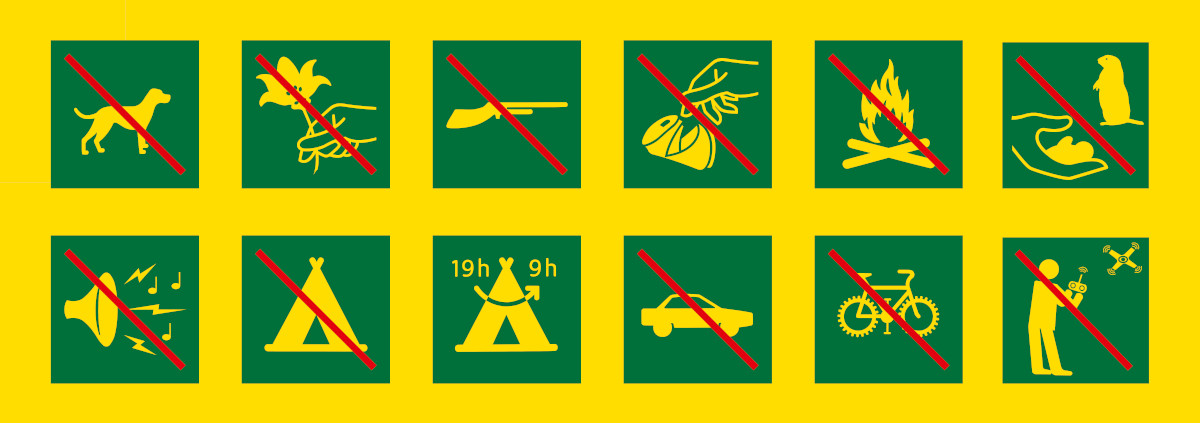Labarre Lake
The walk begins in a mosaic of old flowered prairies, scree with a few scattered trees, orange lis and asphodels. Soon there will be no more trees but lush grass through which flows the Fayolle stream. The pastures and their hut appear as the relief softens. The last rocky protrusion can be seen. They are the base of the small glacial cirque in which the lake is set itself surrounded by a short alpine lawn or gentians and small buttercups that group together in a carpet of colour.
Bernard Nicollet, Warden in the Valbonnais area
13 points of interest
 Flora
FloraAlpine garden
More than fifty years ago, a botany lover, who is now elderly, created a small alpine garden in the centre of the village. Although it is less well kept nowadays, it still presents a stunning array of colour and a collection of spectacular plants belonging to alpine flora. History
HistoryViewpoint over the hamlet of Vasenestre
In the 19th century, the hamlet of Valsenestre had roughly one hundred inhabitants. The main activity was breeding. In 1851, a marble quarry opened in the bottom of the valley on the way up to the Muzelle pass. This was an opportunity for the village. It welcomed the quarry workers and benefitted from an improved road. Marble production stopped in 1905. Up until 1926, children laughing and shouting could still be heard in the village. The school had about thirty pupils. It was closed a few years later and the last permanent inhabitant of the village left in 1948. Architecture
ArchitectureRestored village
Valsenestre is a flower-filled village that has been superbly restored and is now made up of holiday homes The road is not cleared of snow in the winter. When the village had one hundred or so inhabitants it had a school (that has since been changed into a gîte d'étape (bed and breakfast halt), that closed in 1936. It was entirely buried by an avalanche in the 19th century. The main activity was still breeding but the opening of a marble quarry from 1840 brought complimentary resources to workers in the village. The last permanent inhabitant left Valsenestre in 1959. Fauna
FaunaAlpine ibex and golden eagle
Reintroduced into the Valbonnais area in 1989 and 1990, the number of ibex is slowly increasing on the high summits of Valouffrey. A population of about fifty spend the winter on the well-exposed slopes of the Valsenestre valley. Some of them spend weeks on the rocky ledges of Peys above the village, waiting for brighter days. Some years, the golden eagle also comes to build its nest and raise its young. It is not rare to see it or hear it yapping above the footpath. Flora
FloraGiant scabiosa
This giant of the subalpine lawn looks like and is the size of an artichoke? In addition, it has a large round deep pink flower head with a pearly rim. Its huge leaves, that are white and velvet-like on the underside, are impressive and make it easy to identify. Sound nutrition for several species of beetle, its flower head is also a treat for butterflies. This plant species is not common and is protected on a national level even outside the Park. Fauna
FaunaThe aspic viper
It has been a victim of legends and a bad reputation for centuries, but walkers that have been bitten are rare. This reptile that is, on average, fifty centimetres long, has a snubbed nose and a black, thin, vertical pupil, likes the well-exposed slopes. It seeks refuge in piles of stones and thorny thickets where it has no trouble catching small rodents and insects. Flora
FloraOrange Lis
Due to its original and bright colour, it is easy to recognise on the steep terraces and rocky ledges. The orange lily is a rock lover that needs light and warmth, but not too much. This is why it blossoms at the beginning of summer to avoid strong heat. It is forbidden to pick it within the mountain National Parks, but also in several counties including the Hautes Alpes. Elsewhere picking is limited by decree. Fauna
FaunaMountain Apollo
One of the most beautiful butterflies you will come across in the mountains, its generally calm behaviour means it is easy to observe. It is linked to "camel" plants such as houseleeks that grow in dry conditions. They lay their eggs on this host plant, so that the larvae will be able to eat them. Flora
FloraWhite asphodel
They grow in groups, often accompanied by the yellow gentian, on the old hayfields, which have deep soil. Its tall candle-like appearance is easy to recognise and its flowers that are grouped together in a flower spike, blossom one after the other over several weeks at the beginning of summer. Its fleshy tuber attracts underground rodents. It was previously used in the form of flour, to feed the mountain people in times of food shortage. Pastoralism
PastoralismCombe Guyon pastures
They grow in groups, often accompanied by the yellow gentian, on the old hayfields, which have deep soil. Its tall candle-like appearance is easy to recognise and its flowers that are grouped together in a flower spike, blossom one after the other over several weeks at the beginning of summer. Its fleshy tuber attracts underground rodents. It was previously used in the form of flour, to feed the mountain people in times of food shortage. Fauna
FaunaGriffon vulture
This enormous bird of prey, that has a span of almost three metres, is new to the mountains, thanks to a programme to reintroduce them dating from the end of the 20th century. In the summer, they swirl in the sky incessantly as a group looking for sheep corpses or other large wild mammals that they can tear apart for food. This impressive scavenger plays a welcome role in the healthy condition of the pastures. Fauna
FaunaCommon rock thrush
Generally known as the rock blackbird, the male thrush stands out due to its bright contrasting colours and its melodic song. African in winter and alpine in summer, this magnificent migratory bird chooses open areas above the forests where it settles on rocky perches to sing and nests in the scree or other rocky nooks and crannies. Lake
LakeLabarre Lake
This medium sized lake, like many in the Alps, formed in the natural hollow or a cirque at the time of the great glacier retreat at the end of the 18th century. It was due to their force that, over time, they were able to sink into the soft rock and pass over the harder ones. Melt waters from the surrounding névé form runoffs filled with fine rock debris that flow into the one and a half hectare, 8 metre deep Labarre Lake. This is what gives it its distinct colour.
This medium sized lake, like many in the Alps, formed in the natural hollow or a cirque at the time of the great glacier retreat at the end of the 18th century. It was due to their force that, over time, they were able to sink into the soft rock and pass over the harder ones. Melt waters from the surrounding névé form runoffs filled with fine rock debris that flow into the one and a half hectare, 8 metre deep Labarre Lake. This is what gives it its distinct colour.
Description
Go through the hamlet of Valsenestre and turn left after the chapel. Take the footpath that heads West, cross the footbridge over the Rif and continue on the overhang above the Béranger valley, towards the Combe Guyon valley. After a steep climb, cross the footbridge over the Fayolle stream and continue on the right bank. After a few bends through the grass and a long upward crossing, you will reach the Combe Guyon pastoral hut (water source). Continue up the bottom of the valley until you reach 2082 m in altitude, cross the stream and follow the large bend that will take you above the rocky ledges that circle it. You will soon arrive at the Labarre Lake. Return to Valsenestre by the same route.
- Departure : Valsenestre
- Towns crossed : Valjouffrey
Forecast
Altimetric profile
Sensitive areas
Golden eagle
- Impacted practices:
- Aerial, , Vertical
- Sensitivity periods:
- JanFebMarAprMayJunJulAug
- Contact:
- Parc National des Écrins
Julien Charron
julien.charron@ecrins-parcnational.fr
Golden eagle
- Impacted practices:
- Aerial, , Vertical
- Sensitivity periods:
- JanFebMarAprMayJunJulAug
- Contact:
- Parc National des Écrins
Julien Charron
julien.charron@ecrins-parcnational.fr
Recommandations
Avoid going to the Combe Guyon hut out of respect for the shepherd and his dogs.
 In mountain pastures, protection dogs are there to protect the herds from predators (wolves, etc.).
In mountain pastures, protection dogs are there to protect the herds from predators (wolves, etc.).
When I hike I adapt my behavior by going around the herd and pausing for the dog to identify me.
Find out more about the actions to adopt with the article "Protection dogs: a context and actions to adopt".
Tell us about your meeting by answering this survey.
Information desks
Maison du Parc du Valbonnais
Place du Docteur Eyraud, 38740 Entraigues
Reception, information, temporary exhibition room, reading room and video-projection on demand. Shop: products and works of the Park. Free admission. All animations of the Park are free unless otherwise stated.
Transport
Transisère bus to Entraigues
Access and parking
D26 from La Mure then D117 at Entraigues and D117a at La Chapelle en Valjouffrey.
Parking :
More information
Source

Report a problem or an error
If you have found an error on this page or if you have noticed any problems during your hike, please report them to us here:


